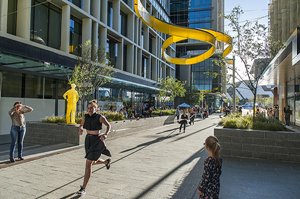 Ephemeral Art in Perth:
Ephemeral Art in Perth:
Making Place of Space
Words by Leatitia Wilson
Perth suffers “the character of an oversized shopping mall – dominated by commercial activities during the days and very inactive, closed, and uninviting during the nights,”[1] said the authors of the 2009 Gehl Architects survey of the city. In addition to a need for changes to the built environment, the authors identified an increased demand for cultural events and participation in activities in the public realm. Since then steps have been taken to shift the dismal mall characterisation, including major redevelopments, support for PIAF and Fringeworld programming and new public artworks.
The redevelopment of the Cultural Centre and Forrest Place, the connection of the city to the waterfront, laneway revitalisation and more recently the Yagan Square link have been ushered in with a wealth of rhetoric about making the city more liveable, more enjoyable, more accessible and more walkable. They are promoted not solely as liminal spaces through which to shop, eat and transit, but places to linger in and enjoy diverse experiences.
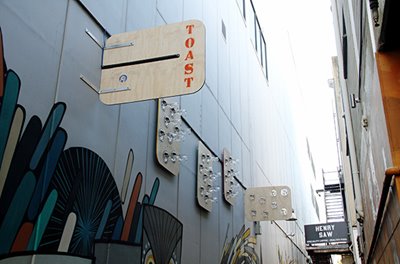 In cities globally there are clear distinctions between what makes a space and what makes a place. Space is anonymous, ambivalent; it could be anywhere or nowhere, a non-place that could become some place. Place implies meaningful belonging to a defined environment, somewhere invested with energy and made something of. As inhabitant or tourist to a city it is impossible not to take in public space and it operates at the level of the imagination as much as being a physical environment. Within that space, art activates the imagination, nurturing a sense of identification to place as well as providing visual and auditory stimulus. Although too often ill considered, art has a crucial role to play within placemaking.
In cities globally there are clear distinctions between what makes a space and what makes a place. Space is anonymous, ambivalent; it could be anywhere or nowhere, a non-place that could become some place. Place implies meaningful belonging to a defined environment, somewhere invested with energy and made something of. As inhabitant or tourist to a city it is impossible not to take in public space and it operates at the level of the imagination as much as being a physical environment. Within that space, art activates the imagination, nurturing a sense of identification to place as well as providing visual and auditory stimulus. Although too often ill considered, art has a crucial role to play within placemaking.
Over the last two decades we have seen significant progress in the inclusion of art within the urban fabric of Perth. The Metropolitan Redevelopment Authority’s (MRA) Public Art Strategy commissioned in 1995 and the Percent for Art Scheme introduced in 1989, offer support for local artists as well as generating community exposure to art. They have been game changers to the face of art on the streets of Perth, moving the city beyond the tyranny of the bronze monument.
Works like Jeppe Hein’s The Water Labyrinth (2012) provide a lively focal point to an otherwise desolate space. Central to the CBD’s Forrest Place, it is the perfect example of space being transformed into place and attracting all walks of life into its splash;
It seems a model example of a location, once considered hot, sterile and unwelcoming, blessed with the perfect match of a public artwork that enlivens the area, breaks down barriers between people and redefines perceptions of the cityscape in which it sits.[2]
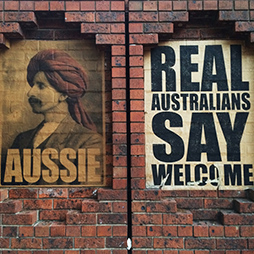 Public art such as this has an impact. It enriches the cultural fabric of a city, creating a more memorable location and physical experience of a place. Yet while it might be a novelty for tourists and a popular part of an outing for regular inhabitants, there is the risk that beyond the initial surprise and rush of participation, it becomes mired in over-familiarity.
Public art such as this has an impact. It enriches the cultural fabric of a city, creating a more memorable location and physical experience of a place. Yet while it might be a novelty for tourists and a popular part of an outing for regular inhabitants, there is the risk that beyond the initial surprise and rush of participation, it becomes mired in over-familiarity.
Another problem facing public art by international creators is that of decontextualisation. While there are great advantages to international artists’ input, as the Hein example demonstrates, local artists responding to local sites bring a wealth of knowledge from the simple fact of inhabiting the place. Intimate knowledge of the local agenda, history, ecology and social dynamics is invaluable. Factoring this in when commissioning public art encourages works that are relevant and meaningful to local inhabitants, significant in placemaking, and ideally distinct from empty spectacle or mere decoration.
Ephemeral art is a form of public art that has historically been linked to land art, environmental practices or happenings and performance. It can also be a significant exercise in placemaking. A recent example is Peter Drew’s posters (above right) pasted on streets throughout Australia. The posters address the refugee issue with the text ‘Real Australians Say Welcome’ and another with a picture of Monga Khan[3] underlined with the single word, ‘Aussie’. As a self initiated and crowd funded project, the posters are an example of how perceptive agitators of space can come out of nowhere, beyond governmental funding bodies. Drew states, “I like to exhibit my art on the street because public space is a great equaliser, and it’s also an ancient forum. When you address the public through the street you’re entering into a tradition that emphasises our fundamental freedom of expression, over the value of property.”[4] Small and unsanctioned street art can be as powerful a marker of place as can large-scale well-funded projects. The posters provoke thought, fuel national debates and put many of us in our place for the time that they remain on the walls. Their impact on space then, is to collapse the national into the local. It is placemaking that triggers thought toward what kind of place we want to inhabit and what kind of values we want to promote.
As “one of the flagship projects in a new chapter in temporary and ephemeral public art commissioned by the City of Perth”[5], TRANSART is a program that since 2009 has supported a range of projects by local artists, often for a month in duration. Experimental, performative, interventionist and audio-based practices are supported, with a broad range of projects selected to attract a diverse audience. Most recently local artists Matt Aitken and Mei Swan Lim created Swamp Clubb, described by them as ‘an immersive, multi-sensory walking tour’. With one tour per week over a month, the artists aimed to generate a sense of place in the face of change by enquiring into Perth’s ecological, socio-cultural and spiritual past. This is one example of a project sensitive to local history, specifically Whadjuk history and the past ecology of Perth as a network of wetlands and it included the participation of key figures such as Noongar elder Dr Noel Nannup.
Whadjuk culture and traditions are a crucial part of our heritage, identity and sense of place, which makes them essential to placemaking in Perth’s public art. While a given space might be considered anonymous or alienating for Wadjellas, to traditional owners it may have once been a place of deep spiritual and ecological meaning.
On this point, the Noongar warrior Yagan is memorialised in the futuristic vision of Yagan Square unfolding in Perth. The MRA promises it will be;
…a place that recognises and celebrates WA’s heritage, produce, environment and culture; representing the coming together of Aboriginal and non-Aboriginal cultures.[6]
The events calendar is coordinated according to the six Noongar seasons and architectural design elements tie into the original inhabitation and lay of the land. A number of public artworks are planned for the space including video, projection, sculpture, Aboriginal art, mobile apps and water features. An LED canopy and digital tower will be the main outlet for digital ephemeral artworks, whereas the public space can have performative and participatory works. It is a promising vision for the city that holds potential for meaningful placemaking.
As with any art, ephemeral art does not always achieve its desired impact. An example is a dance performance titled KS Project (2016) commissioned by the City of Perth, directed by Tyrone Robinson and performed by Storm Helmore, Isabella Stone, Shuling Wong and Imanuel Dado. Held in the recently renovated corridor of Kings Square, Perth, the dancers performed a work to an electronic soundtrack. Despite being regarded as a positive intervention in and invigoration of the new space by those in the arts, it was not well accepted by the general public. There was a wealth of complaints from nearby tenants about noise; the dancers were accused by some of obstructing public space and of being an unwanted distraction in the work environment.
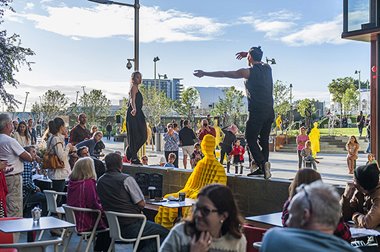 As Robinson observed, “…the lack of understanding from the general public and the lack of willingness to accept art in their ‘work space’, was just a reminder that Perth is very close minded and conservative in their values. It’s no wonder the arts will continue to struggle in Perth when even when art is free and brought right to their door step, it’s still unwanted.” The greatest positive response came from children who encountered the performances and for Robinson this validated the work, because, “…the space became alive and it was clear what the work was meant for; to bring people into Kings Square and to create a sense of something exciting happening in a new space,” he said.
As Robinson observed, “…the lack of understanding from the general public and the lack of willingness to accept art in their ‘work space’, was just a reminder that Perth is very close minded and conservative in their values. It’s no wonder the arts will continue to struggle in Perth when even when art is free and brought right to their door step, it’s still unwanted.” The greatest positive response came from children who encountered the performances and for Robinson this validated the work, because, “…the space became alive and it was clear what the work was meant for; to bring people into Kings Square and to create a sense of something exciting happening in a new space,” he said.
It is the encounter of difference to the habitual rhythms of the everyday that can be taken as a welcome surprise, just as much as it can be seen as a nuisance. Such disruption can be innate to ephemeral art projects, and it should not be taken as a deterrent. Sometimes things need to be shaken up a little, even if this involves ruffling a few feathers.
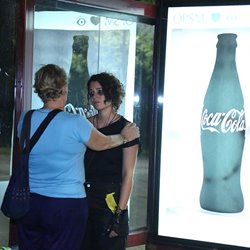 On this point, some of the most consistent practitioners of ephemeral art in Perth are the PVI collective. PVI have staged numerous urban interventions to transform everyday life into a creative experience. Games are one of the key means through which they subvert the status quo. Blackmarket, Deviator, Resist, Inform, Reform, and Transumer invest urban space with a gently disruptive element. For example, Blackmarket (left and below right), for PIAF 2016 was an audiovisual, interventionist game run on the streets of Subiaco. Participants were equipped with smart phones and headphones then invited to engage in activities and peddle personal belongings with PVI performers in a fictional shady underground economy, in preparation for a future economic collapse. This led to ordinary individuals performing out of the ordinary actions on the city streets – like building a cardboard shelter. It was a mild disruption of the kind that PVI refer to as ‘tiny revolutions’. Participants are perceived as creative comrades and granted permission for different types of behaviour within public space. This is playful and humorous ephemeral art with an edge, making place by generating different narratives, unusual actions and allowing strange things to happen. The success of PVI’s work has recently been acknowledged with Kelli McKluskey (co-artistic director of PVI with Steve Bull) being awarded an ‘outstanding achievement for experimental arts’ award from the Australia Council.
On this point, some of the most consistent practitioners of ephemeral art in Perth are the PVI collective. PVI have staged numerous urban interventions to transform everyday life into a creative experience. Games are one of the key means through which they subvert the status quo. Blackmarket, Deviator, Resist, Inform, Reform, and Transumer invest urban space with a gently disruptive element. For example, Blackmarket (left and below right), for PIAF 2016 was an audiovisual, interventionist game run on the streets of Subiaco. Participants were equipped with smart phones and headphones then invited to engage in activities and peddle personal belongings with PVI performers in a fictional shady underground economy, in preparation for a future economic collapse. This led to ordinary individuals performing out of the ordinary actions on the city streets – like building a cardboard shelter. It was a mild disruption of the kind that PVI refer to as ‘tiny revolutions’. Participants are perceived as creative comrades and granted permission for different types of behaviour within public space. This is playful and humorous ephemeral art with an edge, making place by generating different narratives, unusual actions and allowing strange things to happen. The success of PVI’s work has recently been acknowledged with Kelli McKluskey (co-artistic director of PVI with Steve Bull) being awarded an ‘outstanding achievement for experimental arts’ award from the Australia Council.
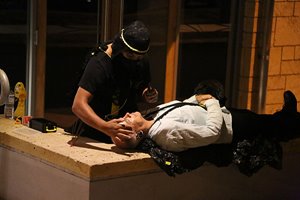 PVI and a wealth of other local and national artists took part in one of the most compelling programs of ephemeral art held in Perth over the last few years. The Non Permanent and Ephemeral Public Art Project (2011) was curated by Consuelo Cavaniglia for the Department of Culture and the Arts and the MRA. Presented in the Perth Cultural Centre, it saw a total of 15 projects unfold over an 18 months period. According to Cavaniglia the project, “…engaged the public in a range of ways – through aesthetic encounters that are out of the ordinary, by involving them through participation, by changing the way they experienced the site and indeed disrupting the flow of their general use of the space.”[7] The time frame of this project was key to providing the Cultural Centre with an ongoing creative edge and bypassed the ‘blink and you’ll miss it’ problem of many ephemeral artworks. This provided a more sustained physical activation of the place and opened up thinking about future uses.
PVI and a wealth of other local and national artists took part in one of the most compelling programs of ephemeral art held in Perth over the last few years. The Non Permanent and Ephemeral Public Art Project (2011) was curated by Consuelo Cavaniglia for the Department of Culture and the Arts and the MRA. Presented in the Perth Cultural Centre, it saw a total of 15 projects unfold over an 18 months period. According to Cavaniglia the project, “…engaged the public in a range of ways – through aesthetic encounters that are out of the ordinary, by involving them through participation, by changing the way they experienced the site and indeed disrupting the flow of their general use of the space.”[7] The time frame of this project was key to providing the Cultural Centre with an ongoing creative edge and bypassed the ‘blink and you’ll miss it’ problem of many ephemeral artworks. This provided a more sustained physical activation of the place and opened up thinking about future uses.
One of the greatest curses and blessings of ephemeral art is its very ephemerality. This necessarily lends it exclusivity, to those in the know or in the right place at the right time, not to mention to those who are already responsive to art. Its fleeting nature means it is more often experienced through documentation than physical presence. However, its sense of urgency does help it overcome the problem of slipping into the background like decorative wallpaper. Instead it offers magical moments of the unexpected to delicately rupture the fabric of the everyday. Ideally ephemeral art contributes to placemaking by creating an aesthetic commons beyond mere beautification or spectacle. It confronts passers by or involves them in dialogue with art, enabling collective sharing that counters capitalistic appropriation and the usual docility of the body in public space. Done well, this art fosters meaningful relations that are built upon sustainable connections and it encourages us to attend to our place and time, in all their complications.
Laetitia Wilson is a Perth-based lecturer, art critic, freelance writer, artistic collaborator and curator with a doctorate in Media Art History. She has curated exhibitions for PIAF and the Lawrence Wilson Art Gallery and worked at Curtin University and the University of Western Australia.
[1] Gehl Architects, Perth 2009: Public Spaces and Public Life, City of Perth, p.14 www.planning.wa.gov.au/dop_pub_pdf/1_Gehl_PSPL_Perth_2009_Introduction.pdf
[2] Bevis, Stephen, ‘The Man Behind the Water Walls’, The West Australian, Nov 22, 2012, www.jeppehein.net/pages/press/pdf/20121122_west-australian_wlperth_eng.pdf
[3] One of the people who received an exemption to the White Australia policy.
[4] Drew, Peter, http://www.peterdrewarts.com/about/
[5] http://www.perth.wa.gov.au/living-community/arts-and-culture/public-art
[6] Metropolitan Redevelopment Authority Brochure, Yagan Square: A Place to Connect and Celebrate Western Australia, 2015, P.1
[7] Cavaniglia, Consuelo, ‘Conclusion’, Non Permanent and Ephemeral Public Art Project, Exhibition Catalogue, DCA, MRA, p.63 www.dca.wa.gov.au/Documents/DevelopingArtsandCulture/SpacesandPlaces/Ephemeralart/NonPermanentandEphemeralArtCatalogueWeb.pdf